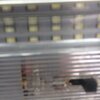i bought a led interior light for my car but keep getting a slight back-feed enough to power the led very dimly when its only on door mode i tried putting a diode on the wire for body module which is where door wire hooks up too it that never worked
inside the light there is (6) 200 ohm resistors per 18 smd led lights which total there is 36 led smd lights and 12 resistors which are all 200ohm
my understanding is there isn't enough resistance for the light when body module is active that it powers the light up through the body module dimly when i tested the wires 12v which is supply roughly 1v is the door when its active then it drops too about 0.4-0.5 volt and stays there and then ground which is grounded to the chassis
would i need to change the smd resistors on the board to higher resistance like 300-400 ohm for it too stop the dim issue or would installing a capacitor like 10v work?
attachment picture is the issue im having when vehicle is in accessory's or run
inside the light there is (6) 200 ohm resistors per 18 smd led lights which total there is 36 led smd lights and 12 resistors which are all 200ohm
my understanding is there isn't enough resistance for the light when body module is active that it powers the light up through the body module dimly when i tested the wires 12v which is supply roughly 1v is the door when its active then it drops too about 0.4-0.5 volt and stays there and then ground which is grounded to the chassis
would i need to change the smd resistors on the board to higher resistance like 300-400 ohm for it too stop the dim issue or would installing a capacitor like 10v work?
attachment picture is the issue im having when vehicle is in accessory's or run


